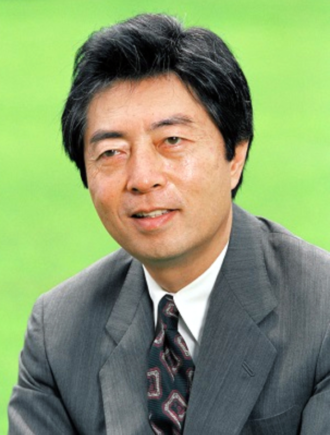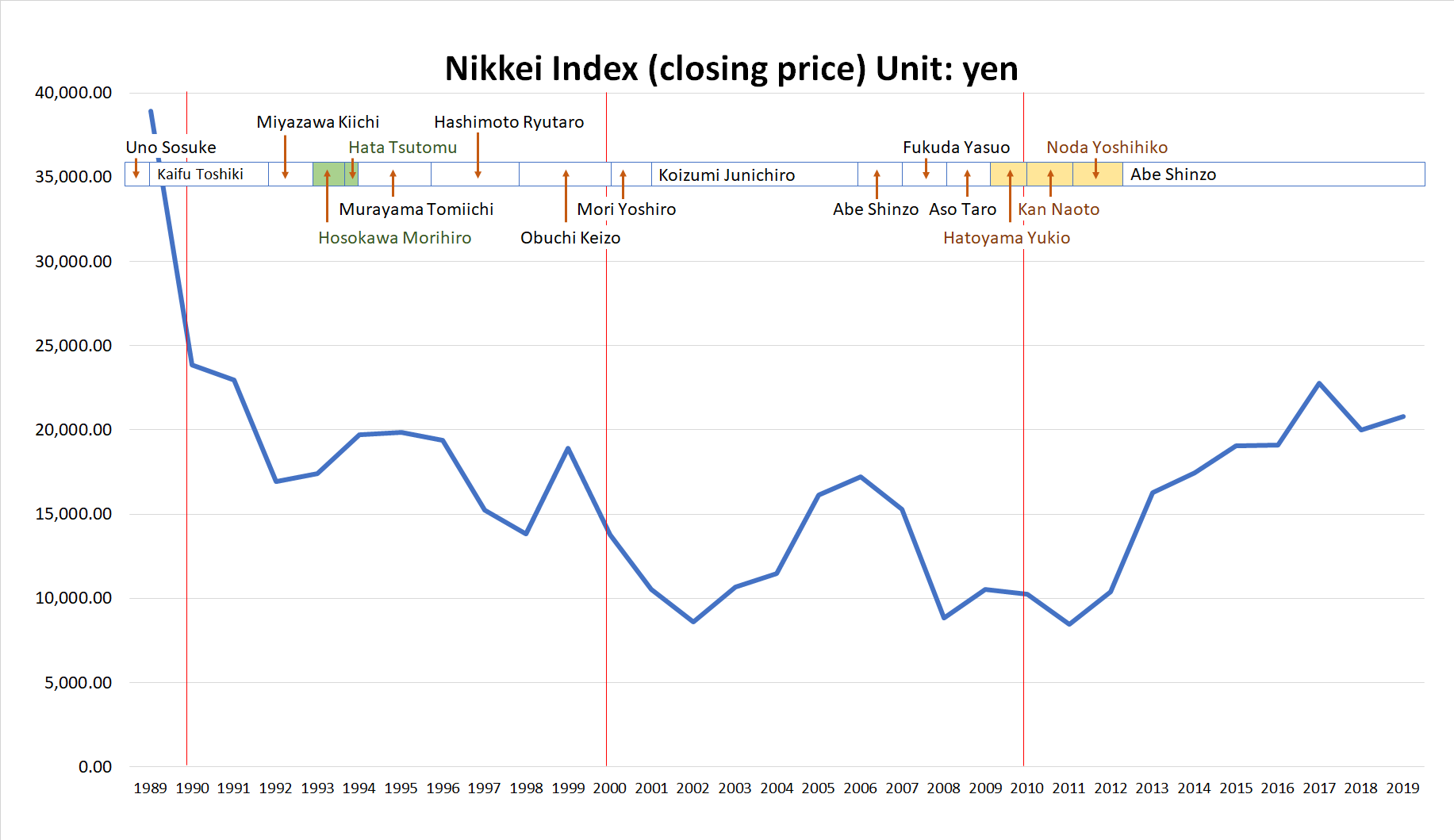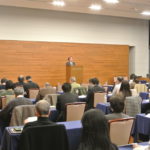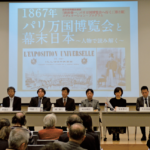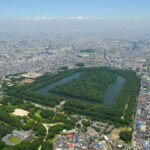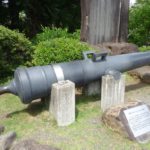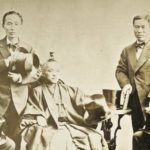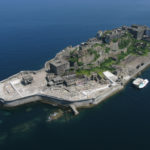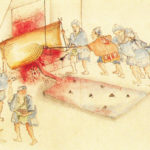Mizuno Tetsu looks back at the 1990s, the 2000s and the 2010s as we enter 2020.
The 1990s began in Japan with the dawn of the Heisei era, following the passing of Emperor Hirohito in 1989, and from a more global perspective with the end of the Cold War, marked by the fall of the Berlin Wall and the subsequent Malta Summit.
The early 1990s saw the beginning of major changes in the global geopolitical landscape, with the reunification of East and West Germany (1990), the appointment of Mikhail Gorbachev as President of the Soviet Union (1990), and the dissolution of the Soviet Union (1991).
Without offering even a moment to think that the world had set out on the road to peace, 1991 saw the outbreak of the Gulf War. In Japan, as a response to this situation, in 1991 it was decided that Japan Maritime Self-Defense Force (JMSDF) vessels would be dispatched to the Persian Gulf, and the following year saw the enforcement of the International Peace Cooperation Law (formally called the Act on Cooperation with United Nations Peacekeeping Operations and Other Operations).
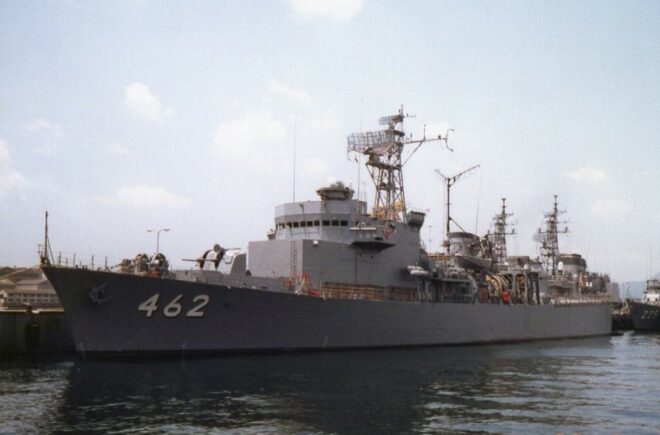
JDS Hayase (MST-462), pictured in the port of Kure in 1986, served as a flagship for removing and disposing of sea mines in the Persian Gulf. YOKOHAMA 1998/CREATIVE COMMONS VIA WIKIPEDIA
Japan sought to respond to the changing global situation, such as with its participation in peacekeeping operations in Cambodia in 1992. The debate on issues surrounding Article 9 of the Japanese Constitution (which renounces war and the use of force as a means of settling international disputes)—which during the Cold War era had been the subject of purely ideological and philosophical disputes—metamorphosed into a series of fierce debates on practical application, with regard to how Japan should contribute as a member of the international community, and how Article 9 should be interpreted and applied in reality. Despite the major changes taking place globally, however, the debate to amend the constitution itself did not gain momentum, and no actual changes were made.
Politics in the 1990s
The decade also saw major changes taking place in Japanese domestic politics. 1993 marked the end of the 1955 system, under which the Liberal Democratic Party (LDP) had held successive majority governments from 1955 until losing its majority in the 1993 general election. Although the LDP had summarized a broad outline for political reform in 1989, the election was won by Hosokawa Morihiro and his newly-formed Japan New Party (JNP) coalition, which advocated for political reform. A combination of LDP intra-party conflicts and breakups resulted in the establishment of a Hosokawa-led coalition government. Less than one year later in 1994, however, Prime Minister Hosokawa suddenly resigned, and the new government lost its cohesive/unifying power. The LDP took advantage of this vacuum, and joined forces with the Japanese Socialist Party (JSP)—its long-time adversary under the 1955 system—to retake control of the government. Murayama Tomiichi of the JSP, who became prime minister and leader of the new administration, put an end to the ideological disputes that had been the fundamental basis for the axis of confrontation between the LDP and JSP under the 1955 system, advocating that the Japan Self-Defense Forces (JSDF) are constitutional, and that the ongoing security arrangement between the United States and Japan was necessary and essential. This stance was not supported by advocates for the protection of the current Constitution, and the JSP suffered a crushing defeat in the 1995 election, after which governmental control reverted to a system centered primarily around the LDP, while the opposition parties continued to engage in a repetitive series of alliances and schisms.
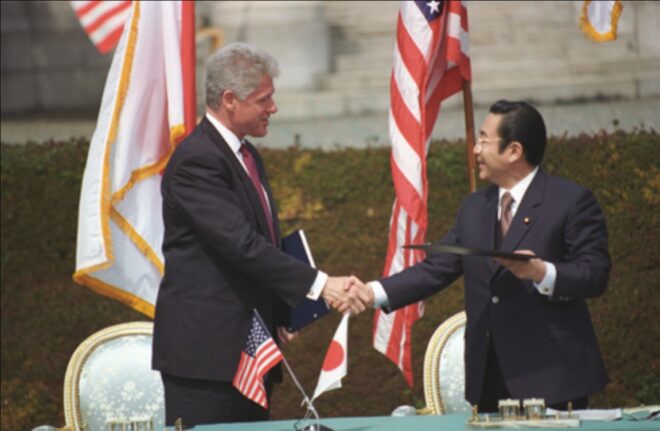
Prime Minister Hashimoto with US President Clinton following the signing of the Japan-US Joint Declaration on Security at the Akasaka Palace, 17 April, 1996. CABINET PUBLIC RELATIONS OFFICE
Hashimoto Ryutaro of the LDP became prime minister in 1996. Domestically he advanced a program of administrative reform, while in the field of US-Japan relations he issued a joint-declaration on security together with US president Bill Clinton in 1996 in relation to the Japan-US Security Treaty (formally called the Treaty of Mutual Cooperation and Security Between the United States and Japan) in the post-Cold War era, wherein the two leaders agreed that the focus of the relationship had shifted from security in the face of former Soviet Russia to wider peace and stable security in the Asia-Pacific region. The following year, in 1997, Hashimoto’s government compiled the Guidelines for Japan-US Defense Cooperation (New Guidelines). This, too, triggered fierce debate on the subject of how Japan (which, under the Japanese Constitution, does not recognize its right of belligerency as a state to become party to armed conflict) should act in the event of military emergencies in its surrounding area, and the limits of what action would be deemed constitutional.
In 1997, North Korea began to test fire ballistic missiles. The following year, in 1998, one of its Taepodong missiles flew over Japan and impacted in the Pacific Ocean, off the coast of the Sanriku Region of northeastern Honshu. As tensions mounted over the situation with North Korea in light of these events, in 1999, a bill was passed in relation to the New Guidelines outlining matters such as the provision of combat service support for United States Armed Forces in the event of military emergencies. Around the same time, the problem of ethnic cleansing (in the former Socialist Federal Republic of Yugoslavia) after the end of the Cold War had reached a point where NATO began a campaign of air strikes against Yugoslavia, during the Kosovo War.
The Economy in the 1990s
During the 1990s, many serious changes also took place in the Japanese economy. The Japanese asset price bubble (or “bubble economy”)—initially originating from the signing of the Plaza Accord in 1985 and monetary easing by the Bank of Japan—continued to grow, with the Nikkei stock average reaching its all-time high of 38,915.87 at the end of December 1989. From March 1991 onwards, however, the economy went into a state of recession, and the bubble eventually burst. During the run-up to this, in 1990, Japan and the United States finally reached an agreement and concluded the Structural Impediments Initiative (SII). In 1991, the following year, the Japan-US Semiconductor Trade Agreement was signed, and Japan’s beef and orange markets were liberalized.
Under these conditions, in 1993, the USD/JPY currency exchange rate plunged to the $1 = ¥100 level, and the yen continued to appreciate until it reached its highest postwar value of $1 = ¥75.31 in 2011. The appreciation of the yen had a direct impact on the Japanese economy, which relied mainly on manufacturing and trading, and became a factor in prolonging the period of economic stagnation that followed the bursting of the economic bubble. Major Japanese corporations began to engage in corporate restructuring (accompanied by employee layoffs) and implemented reforms based on the keywords of “selection and concentration.”
In 1994, despite the fact that Japan’s production of automobiles reached second place in the world, Japan as a whole still remained unable to escape from the grasp of the economic recession. Around this time, Japanese corporations also began to relocate their production plants to China, which had come to be known as “the World’s Factory.” The relocation of production plants also began to spread to other newly developed countries in Asia, and the hollowing out of Japanese domestic industry progressed further still.
1997 saw the occurrence of the Asian Financial Crisis and a simultaneous global decline in stock prices. In Japan, too, the crisis grew, with some financial institutions being driven into bankruptcy. In 1998, the country recorded two consecutive years of negative growth for the first time since the end of World War II. Although the government implemented a string of economic measures, people thought that economic recovery was still a long way ahead, and this pessimistic view spread throughout the country. During this period, consumption tax—which had been introduced in 1989 at a rate of 3%—was increased to 5% in 1997.
Amidst these conditions, between 1995 and 1996, the worsening of the employment rate for new college graduates grew more serious. Companies not only carried out restructuring but also limited their intake of new graduates, filling the gaps with mid-career hires and part-time employees. In the most extreme scenario, a father in the prime of his working life could be laid off, and a mother who had gone out to work in order to make up for the resulting loss of household income could end up stealing the jobs of her newly graduated children. As if it was simply a matter of course, an ironic situation arose in which female college students faced hardships in finding employment, while their mothers took on the role of furthering female social advancement. This, coupled with the growth of the demographic of young people not in fixed employment—commonly referred to as freeters (part-time jobbers)—who increased rapidly in number during the 1990s, meant that employment for young people became a major problem during the decade. As the decline in the size of the working population progressed as a result of overall population decline, the future of the Japanese economy soon developed into an unmissable and dramatic tragedy.
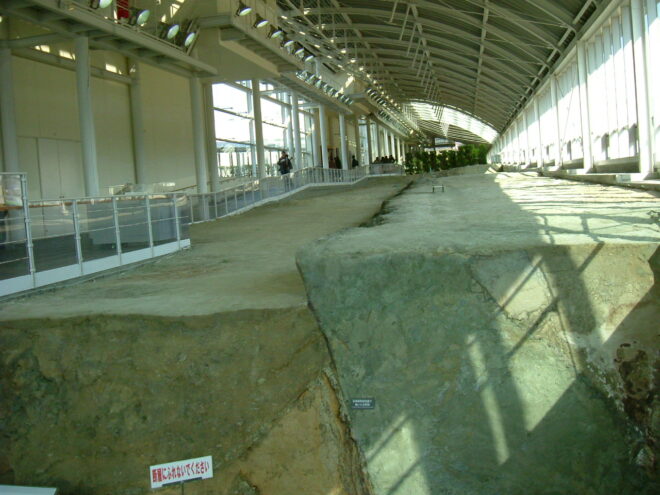
A section of the Nojima Fault, responsible for the 1995 Great Hanshin earthquake, at the Nojima Fault Preservation Museum on Awaji Island, Japan. SAKURAI MIDORI / CREATIVE COMMONS VIA WIKIMEDIA
An even more serious event was the Great Hanshin-Awaji Earthquake, which occurred in January 1995. It was the most destructive major earthquake to hit an urban center since the Great Kanto Earthquake of 1923. This was followed just over two months later, in March 1995, by the sarin gas attack on the Tokyo subway, plunging Japan into a state of terror and great anxiety.
But the Great Hanshin-Awaji Earthquake also brought hope to the people of Japan. The Japanese were grateful for the support given by people from around the world for this massive earthquake that occurred in a major city, and it helped them to strengthen their resolve. Men and women of all ages rushed to Kobe from around Japan to offer their help. The network established at the time—centered primarily around NGOs—continues to engage in activities today, providing a framework for volunteers from around the country to rush to provide help whenever a disaster occurs. For this reason, 1995 came to be referred to in Japan as the First Year of Volunteering, and became a major turning point for Japanese civil society.
Amidst all of the gloom and tragedy of the decade, there was some bright news in the field of science and technology. In 1990, Akiyama Toyohiro became the first Japanese astronaut, and in 1994, Mukai Chiaki became the first female Japanese astronaut. In 1991, Iijima Sumio opened up a new area of research with his discovery of carbon nanotubes. In 1993, Nakamura Shuji created blue LEDs, and in 1995 he developed bluish-purple laser diodes. Together with the 1997 launch of the Toyota Prius hybrid car, this was a groundbreaking event, which it had previously been said would be impossible to achieve during the twentieth century.
Science & Technology from 2000
Following the many changes of the 1990s, the millennium year 2000 marked the beginning of a new decade: the 2000s. The decade began with happy news in the field of science and engineering, with Professor Shirakawa Hideki being awarded the Nobel Prize in Chemistry. In 2001, Professor Noyori Ryoji was also awarded the same prize. In 2003, Professor Koshiba Masatoshi won the Nobel Prize in Physics, while Tanaka Koichi was awarded the Nobel Prize in Chemistry. In 2008, Professors Kobayashi Makoto, Masukawa Toshihide and Nambu Yoichiro were awarded the Nobel Prize in Physics, while Professor Shimomura Osamu won the Nobel Prize in Chemistry.
In 2005, the Japanese space probe Hayabusa landed on the small asteroid Itokawa. It subsequently became the first spacecraft to successfully collect a sample of asteroid material and return it to Earth (which it achieved in 2010). All Japanese people wished for the safety and successful return of the probe, as if watching over a lone human adventurer.
In 2007, Professor Yamanaka Shinya and his group at Kyoto University established the iPS cell (induced pluripotent stem cell) formation technology that would later win the professor a Nobel Prize of his own.
Moving into the 2010s, Professors Suzuki Akira and Negishi Eiichi won the Nobel Prize in Chemistry. In 2012, Professor Yamanaka Shinya (see above) was awarded the Nobel Prize in Physiology or Medicine. In 2014, Professors Akasaki Isamu, Amano Hiroshi and Nakamura Shuji were awarded the Nobel Prize in Physics. In 2015, Professor Omura Satoshi won the Nobel Prize in Physiology or Medicine, while Professor Kajita Takaaki was awarded the Nobel Prize in Physics. In 2016, Ohsumi Yoshinori won the Nobel Prize in Physiology or Medicine. In 2018, Professor Honjo Tasuku was awarded the Nobel Prize in Physiology or Medicine, while Professor Yoshino Akira won the Nobel Prize in Chemistry in 2019.
In addition to these prizes, in 2014, astronaut Wakata Koichi was appointed as the first Japanese captain of the International Space Station, while back on earth engineers began the construction of the Chuo Shinkansen (maglev). 2016 saw the official recognition of the chemical element Nihonium (atomic number 113), the name of which comes from the common Japanese name for Japan (Nihon). In 2019, an international joint research group including members from Japan, the United States and various European countries succeeded for the first time in photographing a massive black hole. That same year, the space probe Hayabusa 2 (launched in 2014) took samples of sub-surface material from the asteroid Ryugu, and departed the asteroid on its return journey back to Earth. Despite these great achievements, we also must not forget the major scandal surrounding the claimed discovery of STAP cells (stimulus-triggered acquisition of pluripotency cells) in 2013, which shook the Japanese scientific community.
The Economy from 2000
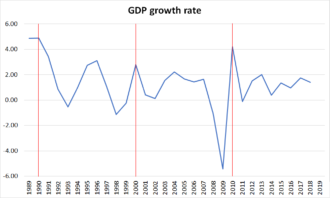 Even moving into the 2000s, the Japanese economy continued to struggle. In 2001, the Japanese government officially announced that the economy was in a state of deflation. The effects of long-term economic stagnation, corporate restructuring (layoffs) and changes in modes of employment during the 1990s were also apparent in the number of homeless people (25,296) recorded as living on the streets of Japan in 2003. That same year, the number of elderly people in Japan of age 75 and above reached 10.04 million. In 2004, the Nikkei stock average recorded a low value of 7,603.76. The post-bubble economy had finally hit rock bottom.
Even moving into the 2000s, the Japanese economy continued to struggle. In 2001, the Japanese government officially announced that the economy was in a state of deflation. The effects of long-term economic stagnation, corporate restructuring (layoffs) and changes in modes of employment during the 1990s were also apparent in the number of homeless people (25,296) recorded as living on the streets of Japan in 2003. That same year, the number of elderly people in Japan of age 75 and above reached 10.04 million. In 2004, the Nikkei stock average recorded a low value of 7,603.76. The post-bubble economy had finally hit rock bottom.
In 2007, however, the mass mandatory retirement of the baby-boomer generation began. Although on one hand this became a social security problem, at the same time it also drew attention to the possibilities offered by these baby-boomers—who had been the main players in Japan’s period of rapid postwar economic growth and underpinned the diversity of consumer markets—in opening up a new elderly consumer market; and the possibilities of changing Japan’s approach to senior society, particularly in the fields of healthcare and nursing care.
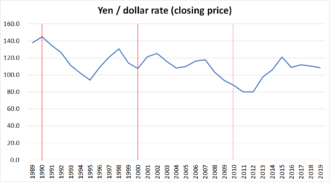 However, with the global financial crisis triggered by the collapse of Lehman Brothers in 2008, share prices plummeted, and the Nikkei stock average fell to below 7000 for the first time in 26 years. By 2010, the economy seemed to be recovering steadily, but in 2011 the exchange rate fell to a postwar record low of $1 = ¥75.31 against the dollar. The Democratic Party of Japan (DPJ) government of the time made a cabinet resolution to raise the consumption tax rate, initially to 5% in 2012, then subsequently to 8% in April 2014 and 10% in October 2015.
However, with the global financial crisis triggered by the collapse of Lehman Brothers in 2008, share prices plummeted, and the Nikkei stock average fell to below 7000 for the first time in 26 years. By 2010, the economy seemed to be recovering steadily, but in 2011 the exchange rate fell to a postwar record low of $1 = ¥75.31 against the dollar. The Democratic Party of Japan (DPJ) government of the time made a cabinet resolution to raise the consumption tax rate, initially to 5% in 2012, then subsequently to 8% in April 2014 and 10% in October 2015.
The DPJ also reached a tripartisan agreement with the LDP and Komeito promising integrated reforms on tax and social security, but then suffered a massive defeat in the December 2012 election.
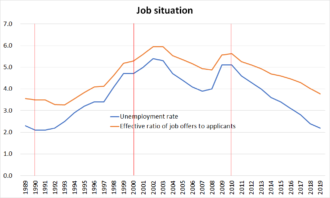 After the LDP’s triumphant return to power, in 2013, Prime Minister Abe Shinzo (who had returned to form his second cabinet) announced the set of economic policies referred to as Abenomics, and promised economic rejuvenation and an escape from deflation under the slogan “Japan is back.” Many economic indicators—including unemployment, exchange rates and share prices—began to improve. In the short term, however, concerns for the future were still growing, with Japanese national debt standing at ¥1008.6281 trillion (as of June 30, 2013), and a population of only 79.01 million people of productive working age.
After the LDP’s triumphant return to power, in 2013, Prime Minister Abe Shinzo (who had returned to form his second cabinet) announced the set of economic policies referred to as Abenomics, and promised economic rejuvenation and an escape from deflation under the slogan “Japan is back.” Many economic indicators—including unemployment, exchange rates and share prices—began to improve. In the short term, however, concerns for the future were still growing, with Japanese national debt standing at ¥1008.6281 trillion (as of June 30, 2013), and a population of only 79.01 million people of productive working age.
Although Abenomics is not commonly recognized as having produced sufficient results, what Prime Minister Abe terms as “diplomacy that takes a panoramic view of the world map” can be viewed as having led to achievements such as the effectuation of the Japan-Australia Economic Partnership Agreement in 2015, TPP11 in 2018, and the Japan-EU Economic Partnership and Japan-US Trade agreements in 2019.
Natural Disasters
Amidst these conditions, there were also many natural disasters. Although comparatively few disasters occurred during the 2000s, moving into the 2010s there was a continuous series of large-scale disasters. The Great East Japan Earthquake of 2011 was particularly destructive, as it was accompanied by a tsunami and a nuclear accident. At this time, too, people from around the world offered their support, and Japan came together in working towards recovery and reconstruction in the wake of the disaster. Despite objective scientific basis having been displayed with regard to the safety of regions surrounding the site of the nuclear accident, however, some harmful rumors are still continuing. The process of recovery is still continuing, and must be completed.
Damage from natural disasters continued with the 2014 Kumamoto Earthquake, the 2018 Hokkaido Eastern Iburi earthquake, and heavy rainfall accompanying Typhoon Faxai and Typhoon Hagibis in 2019. As Japan was hit by a series of large typhoons, organizers of the first ever Rugby World Cup to be held in Japan were forced to cancel some games, although the competition came to a successful end as a result of the efforts of tournament staff, venues and volunteers. Many Japanese people—not least the many bandwagon fans—became engrossed in the excitement of the competition as they watched not only the valiant efforts of the Japanese national team (competing under the slogan “One Team”) but also the clashes between the world’s most powerful rugby teams, and their mutual praise for one another. Along with the enthronement of Emperor Naruhito, the tournament proved to be one event that enabled Japanese people to feel a strong sense of unity.
International Affairs
Changes in the international situation during the twenty-year period spanning the 2000s and 2010s had a greater effect on Japanese politics than ever before. In response to major world events such as the September 11 terrorist attacks, the Iraq War, nuclear tests and missile test-firing by North Korea, the formation of the Islamic State, and various other changes in the global geopolitical climate, Japan made decisions on key issues such as the handling of overseas military emergencies, overseas dispatch of the JSDF, counterterrorism measures, the right of collective self-defense and the enactment of key peace and security-related legislation.
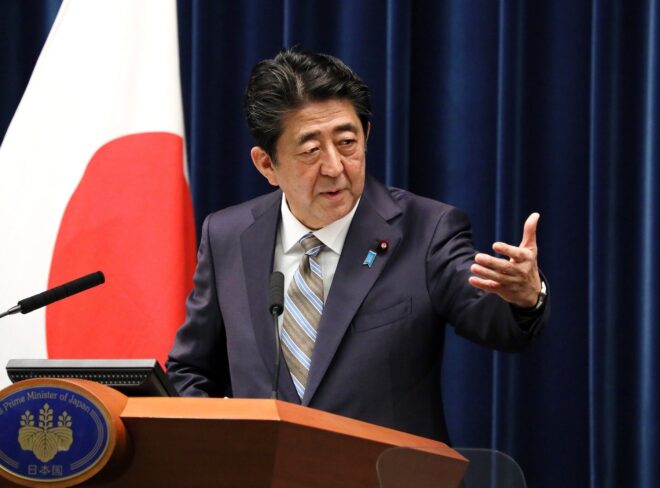
Prime Minister Abe discusses constitutional amendment at a press conference on December 9, 2019. CABINET PUBLIC RELATIONS OFFICE
In the 2009 election, the JDP came to power by garnering the hopes and expectations of voters with promises of fresh, new politics and a two-party political system. The JDP failed to produce results, and in the 2012 election the LDP once again emerged victorious, with a landslide victory, and formed a coalition government together with Komeito. Since then, and until the end of the 2010s, the opposition parties have obsessed themselves primarily with criticizing the Abe administration instead of policy debate envisaging the future of Japan, and continued to engage in a series of alliances and schisms.
Although these alliances and re-alliances also constitute an attempt to establish an effective opposition to Prime Minister Abe’s government, if these factions are unable to find common philosophies and policies then their efforts will only end in a repeat of the poorly performing JDP government of 2009.
In 2016, the voting age in Japan was lowered from 20 to 18. Despite this change, however, young people’s interest and awareness with regard to politics will not increase under this current situation. Elsewhere in the world, young people have stood up in response to the call of a 16-year-old girl who has advocated for concern and measures by the next generation to combat environmental issues. An 18-year-old singer-songwriter has sung about the threat posed by global warming, and in Hong Kong young people are fighting for the autonomy and free future of their homeland.
Facing the Future
To make a deliberate point of saying so, the key decisions made by Japan during these last twenty years will all be inherited and carried on by future generations together with the country’s deficit-covering government bonds.
In the current era, the advance of globalization cannot be avoided, and the growing influence and impact of the voices and actions of the general public—focused primarily around social media—cannot be ignored. Japan must approach politics with greater sincerity, facing up to the views and opinions of future generations, and the younger generations themselves must face the future without falling into a state of nationalism.
The beginning of the 2020s in Japan is marked by the hosting of the the 2020 Tokyo Olympics and Paralympics. In 2025, the realization of Society 5.0 will be achieved through the hosting of Expo 2025 Osaka, Kansai, Japan. Both of these events are celebrations of peace, passing on the future of Japan to the next generation.
Like many other countries around the world, Japan has many issues to tackle. I would like to pay keen attention to how Japan will handle these two fantastic opportunities to make leaps of progress on the global stage, and chances for major transformation, and what kind of new models Japan can present to the world.
MIZUNO Tetsu is a freelance writer.

